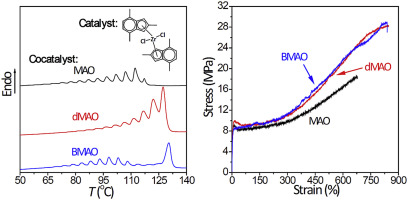Polymer ( IF 4.1 ) Pub Date : 2017-06-21 , DOI: 10.1016/j.polymer.2017.06.042 Yintian Guo , Zhisheng Fu , Junting Xu , Zhiqiang Fan

|
Ethylene/propylene copolymerization was catalyzed under the same conditions with unbridged metallocene bis(2,4,7-trimethylindenyl)zirconium dichloride (Cat.1) activated by aluminoxane type cocatalysts having different content of trimethylaluminum (TMA). Chain structure of the copolymers was characterized by 13C NMR and thermal analysis on copolymer fractions separated based on crystallinity. Changing the cocatalyst from commercial methylaluminoxane (MAO, containing both free TMA and bond TMA) to dried MAO (dMAO, containing only bond TMA) and BHT-treated MAO (BMAO, containing almost no TMA) caused only slight differences in polymerization activity and moderate increase in copolymer molecular weight, but marked differences in copolymer chain structure. The copolymers produced using MAO (sample 1) and dMAO (sample 2) as cocatalysts contain high amount of fractions with very low propylene content and almost isolated propylene units. The copolymer produced using BMAO as cocatalyst (sample 3) has very broad composition distribution, but its fraction with the highest crystallinity has much higher content of PP dyads than the crystalline fractions of the other two samples. This sample has the lowest crystallinity among the three samples. Phase morphology and tensile properties of the copolymer changed markedly when different cocatalyst was used. Tensile properties of sample 1 and 2 were similar to mixtures of elastomer and crystalline plastic materials, but tensile properties of sample 3 were more or less like a thermoplastic elastomer. Influences of TMA on the micro scale environment of active centers were considered the main reason for the effects of cocatalyst on copolymer structure and properties.
中文翻译:

由含不同量三甲基铝的甲基铝氧烷活化的二氯化双(2,4,7-三甲基茚基)锆合成的乙烯/丙烯共聚物的结构和性能
在相同条件下,用具有不同三甲基铝(TMA)含量的铝氧烷型助催化剂活化的未桥连的茂金属双(2,4,7-三甲基茚基)二氯化锆(Cat.1)催化乙烯/丙烯共聚。共聚物的链结构特征为1313 C NMR和基于结晶度分离的共聚物馏分的热分析。将助催化剂从商业甲基铝氧烷(MAO,既包含游离TMA和键TMA)变为干燥的MAO(dMAO,仅包含键TMA)和经BHT处理的MAO(BMAO,几乎不包含TMA),仅引起聚合活性略有差异,且适度共聚物分子量增加,但共聚物链结构明显不同。使用MAO(样品1)和dMAO(样品2)作为助催化剂生产的共聚物含有大量的馏分,其中丙烯含量非常低,几乎没有丙烯单元。使用BMAO作为助催化剂生产的共聚物(样品3)具有非常广泛的组成分布,但是其结晶度最高的级分的PP二元组含量要比其他两个样品的结晶级分高得多。该样品在三个样品中具有最低的结晶度。当使用不同的助催化剂时,共聚物的相形态和拉伸性能发生显着变化。样品1和2的拉伸性能类似于弹性体和结晶塑料材料的混合物,但是样品3的拉伸性能或多或少类似于热塑性弹性体。TMA对活性中心微观环境的影响被认为是助催化剂影响共聚物结构和性能的主要原因。当使用不同的助催化剂时,共聚物的相形态和拉伸性能发生显着变化。样品1和2的拉伸性能类似于弹性体和结晶塑料材料的混合物,但是样品3的拉伸性能或多或少类似于热塑性弹性体。TMA对活性中心微观环境的影响被认为是助催化剂影响共聚物结构和性能的主要原因。当使用不同的助催化剂时,共聚物的相形态和拉伸性能发生显着变化。样品1和2的拉伸性能类似于弹性体和结晶塑料材料的混合物,但是样品3的拉伸性能或多或少类似于热塑性弹性体。TMA对活性中心微观环境的影响被认为是助催化剂影响共聚物结构和性能的主要原因。













































 京公网安备 11010802027423号
京公网安备 11010802027423号